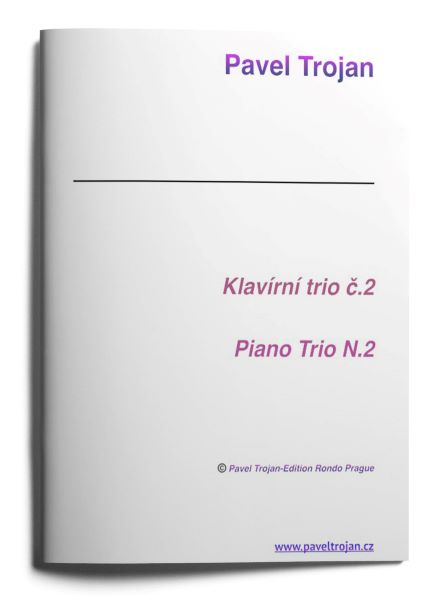Piano Trio N.2, Op. 46
22' (2009)
vln - cello - piano
Four-movement concert piece for piano trio. One of the most performed works of the composer.
Recorded by the Czech trio for the Czech Radio, In 2016 realeased on CD Pavel Trojan (Radioservis).
"Pavel Trojan (1956) wrote his four-movement Piano Trio No. 2 in 2009 at the call and with a dedication to the Czech Trio and created a composition that, with its unusual invention, compositional maturity and imaginative approach to the listener, significantly deviates from the context of contemporary Czech chamber music. Trojan assigned the piano and strings a different role in different movements: the trio opens a fixed motor sequence in the octaves of the piano, both strings are engaged later, and the piano gradually gives up its dominant function to the accompaniment. After Scherzo's 2nd movement, with a balanced use of both aspects, the author again favors the piano in the 3rd part and only in the final movement do string instruments take the upper hand again. Trojan's sonata cycle by the Piano Trio, conceived in this way, gained in impressiveness and tension, and the listeners of the packed Dvořák Hall were clearly captivated and addressed. I think that the composition has all the prerequisites to assert its unusual quality into the repertoire of other ensembles. It deserves their attention and should not just disappear from the concert stage! It has all the prerequisites for this to be a modernly conceived and at the same time tradition-not negating work."
Ludvík Kašpárek, 06/2011, Hedební Rozhledy
Author's word:
"Piano Trio No. 2 was created in 2009 at the invitation of the Czech Trio, to which it is dedicated. The composition is divided into four movements (I. Allegro risoluto, II. Allegro scherzando, III. Andante, IV. Allegro). An important role in its tectonics is played by the diversity of timbres of piano and string instruments. In different parts of the composition, a different emphasis is placed on the role of these instruments. The composition is opened by the piano with a robust motor introduction in octaves, only later do both string instruments with their themes come into play and the piano recedes into the background for the accompanying role. In the second movement (scherzo), the strings and piano pass on thematic material, in the third slow movement, the core of the musical action is entrusted to the piano, the strings complement and highlight the content. On the contrary, the thematic material of the final movement is entrusted primarily to string instruments, the piano accompanies and comments on events and is also the engine of the whole movement."

